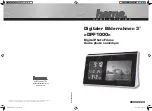
2-16
Chapter 2
Hardware Descriptions
14-Button
i
DCS AOM / STRIP
(Figure 2–23)
y
14 programmable keys with red LEDs
y
One only can be assigned to a keyset to provide
additional programmable keys
i
DCS Series Keyset Daughterboards
[28D and 18D Keysets Only]
(Figure 2–24)
i
DCS 28D and 18D button keysets can have one of three different types of daughterboards
installed on them to enhance operation or to provide an additional local port depending on
the type of daughterboard.
i
DCS KDB-Digital Line Interface (FKDBD)
If your keyset is connected to a Digital Line Interface (DLI) port that supports 2B+D opera-
tion, you may install a daughterboard that provides a Digital Line Interface (DLI) port for con-
nection of a digital station device such as a keyset or 64-button add-on module.
i
DCS KDB-Single Line Interface (FKDBS)
If your keyset is connected to a Digital Line Interface (DLI) port that supports 2B+D opera-
tion, you may install a daughterboard that provides a Single Line Interface (SLI) port for con-
nection of a standard telephone device such as a cordless phone.
i
DCS KDB-Full Duplex (FKDBF)
The standard speakerphone mode of operation for an
i
DCS keyset is “half duplex”. This
means that you cannot transmit and receive speech at the same time. Adding an FKDBF to
your keyset will convert the speakerphone into full duplex mode, enhancing its operation. In
addition, the FKDBF may have up to three external microphones attached to it for conference
room type applications. These microphones require an “EXTMIC” key programmed on the
keyset to activate or deactivate them.
Figure 2–23 14-Button
i
DCS AOM/Strip
(connected to keyset)
Figure 2–24
i
DCS Series Keyset
Daughterboards
















































